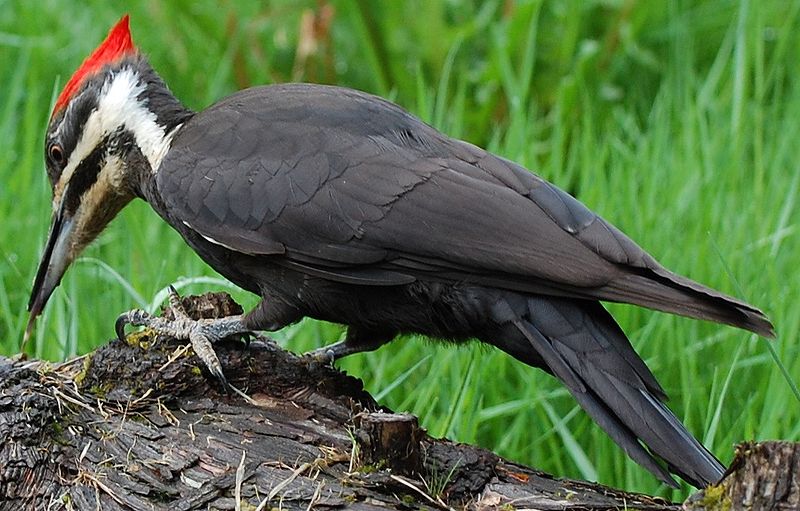Bob Glotzhober wrote this for the recent edition of “The Columbus Naturalist”, the newsletter of the Columbus Natural History Society. Enjoy!

Pileated Woodpeckers, by Louis Agassiz Fuertes
Magic is all around us in the natural world. It takes many forms. Sometimes it requires hard work or even sophisticated scientific knowledge to grasp what is happening. Therefore, sometimes we fail to see the magic. At other times, we are just too distracted by modern life to pay attention and see the magic. Sometimes serendipitous magical situations jump out in front of us and practically assault us, forcing us to see them. One such event forced itself upon me and a group of third graders, quite a few years past. The normal hyperactive and short attention spans of typical third graders were momentarily erased, as I watched them in what might have been a group hypnotic trance. Only I too was caught in that same hypnotic trance.
I was leading a group of third graders along a nature trail near Vienna, Virginia. For a couple of weeks, I had observed a pair of Pileated Woodpeckers excavating a nesting hole in a large tulip poplar right on the edge of our trail. In the last few days, I had heard the high-pitched peeps or squeaks of hatchlings coming from inside the hole, which was at least 20 feet up in the tree. On this morning I stopped the group near the tree and pointed out the nesting hole. I explained to the kids what these crow-sized woodpeckers looked like and how shy they were. I suggested that if we could all be still and very quiet, we might catch a look at one of the adults coming to the nest or at least hear the peeping of chicks, which I assumed were still in the nest hole.
The kids were really good as we stood there for a few minutes quietly waiting to see or hear something. Patience was beginning to wear thin when a small movement off to our side caught my attention. There partway up the side of a huge oak tree, not ten yards away, was the adult male. He was propped up almost motionless on the side of the oak tree perhaps fifteen feet off the ground. He sat there clinging to the bark as if on display only for us! What a magnificent bird with its nearly black wing and tail feathers contrasting with the white streaks on its head and neck, topped with a bright red pointed crest. The small red “moustache” streaking out from the rear edge of the beak declared to us this was a male. I pointed out to the group its large beak, and explained how the bird can prop its stiff, pointed tail feathers against the trunk, giving it a strong tripod from which to strike powerful blows against the wood to chisel out holes in search of carpenter ants or other insects to eat. I also explained how woodpeckers’ tongues curl around the top of their head and can stretch out longer than the beak. The birds use their long tongue to follow ant tunnels in the wood and snag dinner with the sticky, barbed tip. We sat spellbound for nearly five minutes watching this huge, normally shy bird.

Pileated Woodpecker, photo by Andrew Brownsword
Then the Pileated male took a couple of short hops on the trunk, and we noticed something we had not yet seen. There was a huge black rat snake, probably about five-foot long, that had climbed up the tree and had been temporarily frozen into a motionless position just below the woodpecker. Woodpecker and snake seemed to be at a standoff. Black rat snakes are good tree climbers, and are known to eat eggs or the young of birds or even adult birds and squirrels, if it can surprise them in the tree tops. While the snake was in an oak more than ten yards from the woodpecker’s nest tree, this woodpecker apparently felt that was still too close of a threat to its nest and young.
As we watched, the activity of the woodpecker and the snake slowly escalated. The Pileated took a couple of more hops, closer to the snake. Then the woodpecker struck at the tree trunk, perhaps something like an angry man pounding on a desk top. The snake was big enough to eat the woodpecker if it could find an opening to attack, and it moved its head more toward the bird. Suddenly the woodpecker acted first, flitting over onto the snake’s back and striking the snake’s body repeatedly with its inch-long chisel-like beak. The snake dropped from the tree as the woodpecker followed it down and hit it a couple of more times on the ground. At this, the snake sought escape, zooming in a straight line path just inches past some of the kids in the group. Snakes can travel in a number of different ways. Normally, we think of their curving serpentine movement, as that is what we most commonly see. This snake, however, zipped past us like a long, almost straight stick! I couldn’t calculate its speed, but it probably set an Olympic record for black rat snakes.
The snake was gone, disappeared into the underbrush. The woodpecker must have finally decided that with its nest hole now safe, it did not need to spend any more time around this group of twenty spectators. Especially since the spectators were no longer quiet! Reverting to its more typical shyness the woodpecker disappeared too.
The magic hypnotic spell was broken. Or was it? I still get a tingle every time I think of the event. It took place in 1976. Those third graders are now in their late forties. I doubt any of them remember me and probably not much of what I told them that day. But I’ll bet none of them have ever forgotten that magic moment!
Bob Glotzhober
Curator Emeritus of Natural History